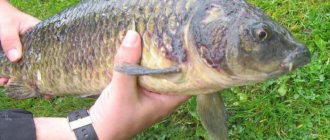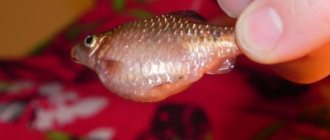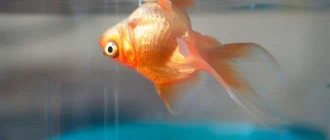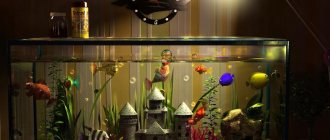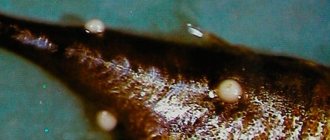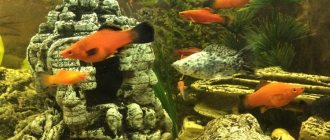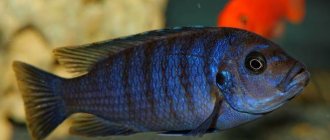How to defrost fish in a water bath
If you need quick defrosting within 30-60 minutes , you can defrost the fish using warm air. Water bath defrosting is a good alternative to liquid defrosting. The exposure temperature will not be too high, so the fish fillet will not lose its taste.
Defrosting fish is simple and convenient. Place a large pot of water on the stove. As soon as the water boils, reduce the heat as much as possible. Place a colander on the pan, and place a small container with fish in it. Please note that the fish should not come into direct contact with the steam, so you cannot put it directly in a colander.
Turn the fish fillets periodically. This will ensure even defrosting on all sides.
Death of fish due to care
The desire to have a mysterious, beautiful underwater world at home overcomes many. But it is rare that one thinks that maintaining an aquarium is a troublesome and responsible task. You won’t be able to simply pour water, throw animals into the water, and sometimes throw food in there.
With illiterate care and care for fish, various problems arise that lead to the death of underwater inhabitants. What should a novice aquarist pay attention to?
Water quality
Water is the precious basis of life for underwater pets. The natural habitat allows fish to feel comfortable, creating conditions for development and reproduction. But the water supplied to apartments from the tap is destructive. There are rules that will help you avoid pet pestilence due to water quality:
Where to get water for an aquarium. Tap water cannot be poured into an aquarium - chlorine and chemical compounds cause the death of fish. Before filling the aquarium, it should be left for 1-2 weeks. When purchasing a new aquarium, the water can be settled in it by draining it once.
Pet stores have special water purification products. But experienced aquarists recommend settling the water even with the use of such preparations.
Water poured into an aquarium gradually acquires color and smell (the reason is the activity of microflora and the development of bacteria). At first it turns blue, then cloudy white. A week after the aquarium is fully launched and the fish appear, the water will become transparent. These processes are normal and natural.
Temperature. To prevent colds in fish, aquarium water is heated to room temperature (+23-26⁰ C). In winter, you cannot place the aquarium on a balcony (even an insulated one); beware of the close proximity of heating devices.
Rigidity. One of the important parameters necessary for the health of pets. Fish are able to live in water of varying hardness, but they urgently need the presence of calcium and magnesium - without these microelements, fish health deteriorates and they die. In an aquarium, the hardness changes regularly - over time, the water softens and loses beneficial microsubstances. Therefore, it should be changed regularly.
The simplest way to prepare water for fish is boiling. After it boils, the water is cooled and sent to settle.
Change of water. You can completely replace aquarium water. But such a task is difficult to perform, and it is not necessary. Easier to purify water. If it is cloudy, using activated carbon filters will help. Old water in an aquarium has a yellowish tint - this color is normal and indicates a developed and established microflora.
How often do you change the water in the aquarium? Replacement occurs weekly, changing 1/5 of the old water to fresh, settled according to all the rules.
Why do fish die after changing the water? The water poured into the aquarium was not settled, with a large amount of bleach, a different temperature and composition. Changing water is stressful for fish; experienced aquarists advise not to change it at all (if the aquarium is 100 liters or more), but to make do with filters.
Aeration. Fish cannot live without oxygen dissolved in water. But there shouldn’t be too much of it (if air bubbles form on the walls of the aquarium, this is evidence of oversaturation of the water with oxygen).
This situation leads to the appearance of a gas embolism (the fish breathe greedily, swim at the surface of the water, turn their tails up, and then die).
Modern compressors help maintain good aeration. Filters with built-in compressors (two in one) are also available for sale.
New fish, how to prevent death
Do not rush to introduce new inhabitants of the underwater world into the aquarium immediately after purchase. To prevent the fish from dying from stress and changes in environment, they are prepared for transplantation:
- Rinse the bag with the purchased animals under running water.
- Place the container with the fish in a dark-colored bucket (previously filled with water from the aquarium).
- Then carefully, in small portions, add water from the aquarium to the bag with the fish.
- After 15-20 minutes, the fish are ready to be released to their permanent place of residence.
This applies to pets moving into a new aquarium that has recently been purchased and prepared. But before introducing animals to your neighbors, they should be kept in quarantine for 2-3 weeks.
For quarantine, select a separate aquarium without soil and plants. Such precautions are necessary to avoid spreading the infection to existing underwater inhabitants.
It is recommended to add decorative fish to the aquarium at night. At first, new individuals will huddle and hide under stones and snags. This is a normal reaction to a change in environment. It is advisable not to feed them the first day (an exception is made for active, young animals).
Some aquarists advise holding each fish for 2-3 seconds in plenty of salt water before releasing them into the aquarium, so that the new inhabitants do not spread the infection to the rest of the fish. Infections are the main causes of death for underwater inhabitants.
Death of fish from food
“A healthy fish is a hungry fish,” as aquarists joke. This is the truth. In the practice of aquarium fish breeders, there are no known cases of pets dying from hunger; more often, fish die from overeating. You cannot throw food into the aquarium uncontrollably! Famous beggars are Angelfish and young Telescopes. They have no sense of proportion, but they know how to beg for food and actively eat it.
Such indiscretion leads to obesity, problems with internal organs and death. Adults are fed once a day (in the morning). And carefully observe how your pets eat food. If the fish eat it reluctantly, constantly spitting it out and letting food particles pass by their mouths, they are full.
In this case, stop feeding and remove excess food. Food residues cause the water to become cloudy and spoil. It is useful for fish to arrange “fasting” days - without giving them food during the day. Young, growing fry are fed 3-4 times a day in small portions (the more often the young are given food, the faster they grow).
For proper feeding, four types of food are used:
Dry. Such food is made in the form of tablets, granules, and flakes. Dry food contains nutrients necessary for the health of fish. But feeding only dry food causes intestinal problems in pets, which causes death.
Alive. This species includes small worms (enitreus and tubifex). Worms are fed to fish in small portions, otherwise the pets will develop obesity. Live food should be thoroughly washed before feeding - worms are carriers of infectious diseases.
Frozen. Aquarists are not particularly inclined towards this type of food - fish are reluctant to eat cold-dried food. But, for variety, you can dilute the diet.
Human food. From everyday human food, fish are suitable:
- For predators. Minced meat, liver, beef heart, seafood (mussels, clams). Boiled chicken, cod roe and boiled fish.
- For herbivores. An excellent variety in the fish menu are spinach, peas, cucumbers and lettuce.
For all types of fish, it is not forbidden to occasionally feed bread, egg yolk, yeast, milk powder, and mixed feed.
Introduce new foods into your diet carefully, in neat portions. A sudden change of food has a detrimental effect on digestion and leads to pestilence. Do not get carried away with meat additives - excess meat food causes obesity in fish.
Death of fish from old age
Aquarium fish are delicate and sensitive creatures. Nature has given them a short lifespan - only a few years. Like all living creatures, underwater pets die of old age.
There is a widespread belief among aquarists that before fish die due to age, pets have the most vibrant, beautiful color. How long does a fish live? Lifespan depends on the species and group.
Carp-toothed. Viviparous fish of the carp-tooth family live on average 3.5 years. These include Swordtails, Pecilia, Guppies, Molinesia.
Labyrinthine. The beauties Gourami, Cockerel and Lyalius will delight the owner for 4-5 years.
Characinaceae. Average life expectancy 7 years:
- Neons 4 years old.
- Tetras 5.5 years old.
- Minors 6 years.
- Metinnis and Piranha are 10 years old.
Cyprinids. Fish of these species live on average 8 years:
- Cardinal 4 years.
- Danio is 6 years old.
- Barbus and Rasbora are 7.5 years old.
- Goldfish and Telescopes 15 years.
Cichlids. Some of the most beautiful and varied in color and shape fish are long-lived aquarium fish. They delight the owner with their beauty for an average of 11 years:
- Apistogram 4 years.
- Angelfish, Cichloma mesanauta and Parrots 10 years old.
- Cichloma meeka 12.5 years old.
- Severum and Discus 14 years old.
Catfish. Fish of the catfish family live on average 8 years:
- Glass catfish 8 years old.
- Speckled catfish 9 years old.
- Tarakatums 10 years old.
How can you tell if a fish is dying? Aging individuals become lethargic and swim poorly. Their fins become thinner and parts of them fall off. An elderly resident of the aquarium stays in one place for a long time, without showing much activity. Dead fish should be removed immediately - as they decompose, the animals release toxins and poison the water.
How to help a dying fish
How to save your pet if it is clear that she is dying? You can try to prolong the life of your pet as a temporary measure. If the fish lies on the bottom, greedily swallows air or swims on its side, carry out an emergency transplant.
An individual in poor health should only be transplanted into settled water at the same temperature as in the aquarium. There must be aeration in the container.
Sometimes the fish comes to its senses, comes to life, and begins to actively move. If a miracle does not happen, you will have to say goodbye to your pet. The well-being of pets is greatly influenced by the passion many owners have for aquarium decor. Excess plastic, metal, rubber negatively affects the well-being of fish.
The main panacea for aquarium troubles is proper care and good maintenance of fish. In most cases, pestilence of underwater pets occurs due to improper actions of the owner. What does this mean:
Popular beliefs
According to historical data, the ancient Egyptians were engaged in fish breeding. Decorative fish are four thousand years old. And the first breeders were the inhabitants of ancient China. The famous art of Feng Shui devoted many pages to the rules of equipping the underwater kingdom in the apartment.
Folk signs about fish
From time immemorial, fish have been considered symbols of carelessness and tranquility. If there is an aquarium in the house, the energy of the home normalizes, becomes favorable and relaxing. The presence of aquarium goldfish promises strengthening family ties and attracting finances to the family.
In Chinese, the characters for “abundance” and “fish” are written in the same script.
Even the death of pets in an aquarium, according to the teachings of Feng Shui, is symbolic of the renewal of life. Underwater inhabitants, protecting the owner, take on his misfortunes, which is why they die, as followers of ancient Chinese teachings believe. In order for the fish aquarium to work 100%, consider the rules for its location in the apartment:
- To the left of the front door. Brings a charge of positive energy into the house.
- On the southeast side. Normalizes relationships between spouses and has a beneficial effect on health.
- On the north side of the house. Increases career success, career advancement and respect from colleagues.
It is not recommended to install aquariums in the bedroom, kitchen and in the south-eastern area of the apartment. To improve your financial well-being, buy a round, rectangular or square aquarium.
Speaking about the number of underwater pets, Feng Shui advises choosing a multiple number (the best option is three individuals). Among them there must be a black fish to ward off misfortunes. To provide your family with comfort, harmony and protection from betrayal, get 9 pets (red and silver).
If the fish die, replace them with new ones and clean not only the aquarium, but also the apartment/house.
